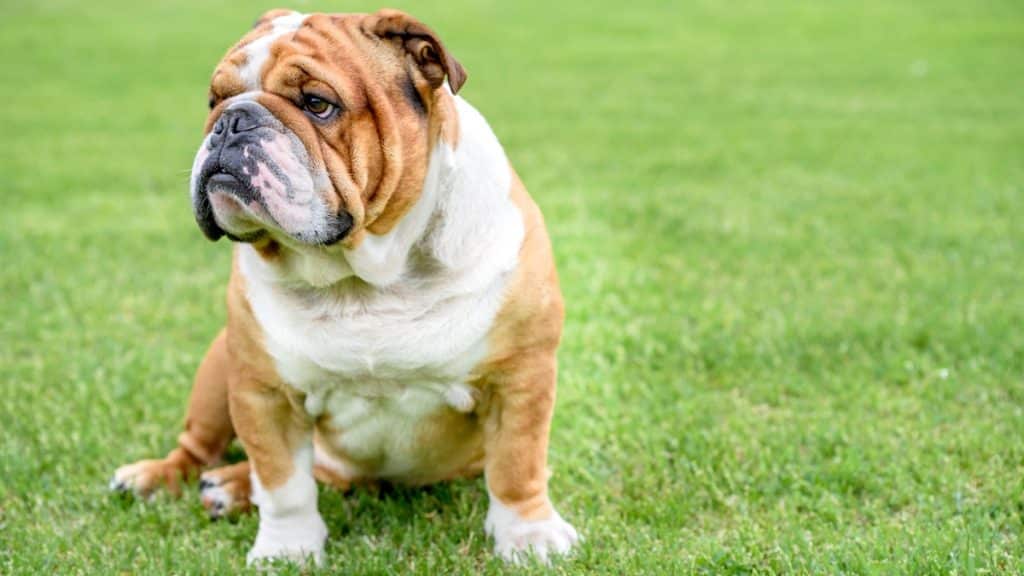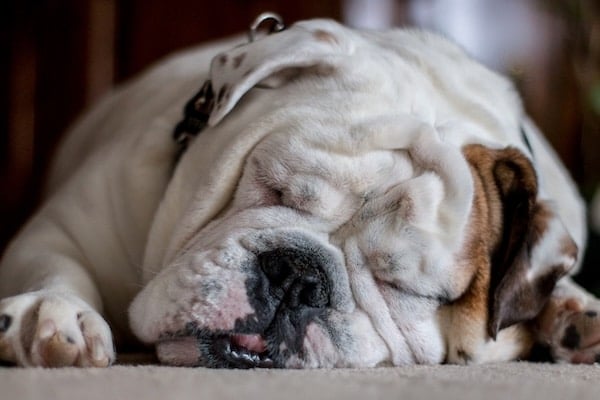
The English Bulldog is one of the most recognizable and popular dog breeds, known for its wrinkled face, stocky build, and signature underbite. Despite their tough, “sourmug” expression, Bulldogs are famously sweet-natured, docile, and low-energy.
According to Annette Nobles, Communications Chair of the Bulldog Club of America, their tenacious spirit has made them beloved mascots for over 40 U.S. universities, including Yale and Georgetown, as well as the U.S. Marines. Ideal for calm households and companionship-focused pet parents, Bulldogs are affectionate homebodies with a lot of heart.
Curious if the English Bulldog fits your lifestyle? Keep reading to explore their background, care requirements, and what it’s really like to live with this iconic companion.
Key Breed Characteristics & Facts
The first thing you’ll notice about an English Bulldog is their distinctive face—wrinkled, jowly, and often wearing a grumpy expression that doesn’t match their true nature. Beneath that tough exterior is a calm, affectionate dog that thrives on companionship and has a surprisingly laid-back attitude.
English Bulldogs typically stand between 14 and 15 inches tall. They are considered a medium-sized breed because of their muscular build.
Female English Bulldogs typically weigh about 40 pounds, and male English Bulldogs are usually closer to 50 pounds.
The English Bulldog is in the Non-Sporting Group because these pups are primarily bred as companion dogs—and their traits don’t neatly fit into other breed groups.
English Bulldogs can be brindle and white, fawn, fawn and white, fawn brindle and white, red, red and white, red brindle, red brindle and white, all white, fawn and brindle, and fallow. Their markings can include a black mask, piebald, white markings, ticked, black tips, and brindle.
English Bulldogs have a short, smooth coat that sheds more heavily during seasonal changes like the spring and fall.
Nobles says that while English Bulldogs love walks and play, they only require moderate exercise for short periods of time. They’re perfectly content lounging around the house and keeping their family company.
English Bulldogs may bark occasionally to alert you to something, but they’re not known for being vocal.
English Bulldogs are known for their wrinkled faces, friendly nature, and relatively low energy levels. They often make great family pets, especially for those who enjoy a relaxed lifestyle.
The English Bulldog has a fairly short life expectancy at an average of 8-10 years, but this can vary based on overall physical health.
English Bulldogs are prone to overheating, skin fold pyoderma, hip dysplasia, and obesity. They are a brachycephalic breed, meaning their flat face makes it more difficult for them to breathe. If they’re not properly cleaned, their face and neck wrinkles can collect bacteria and lead to infections.
Although an English Bulldog will be more than content curled up on the couch with you, they also enjoy regular moderate exercise like brisk short walks.
With consistent training and socialization as puppies, English Bulldogs thrive with other dogs, children, and pets.
Physical Characteristics
English Bulldogs are compact, muscular dogs with a broad, low-slung silhouette and a distinctively barrel-chested frame. Their short, sturdy legs support a heavy, solid body, and their wide stance gives them a unique waddling gait. Bulldogs have large, square heads with deeply wrinkled foreheads, pronounced underbites, and broad jaws. Their ears are small and folded like a rose, and their short, straight tails are either naturally screw-shaped or carried low.
Their short, smooth coat lies close to the body and is easy to groom, with moderate year-round shedding. Bulldogs come in a variety of colors, including brindle, fawn, white, red, and piebald. Adult Bulldogs typically stand 14 to 15 inches tall at the shoulder and weigh between 40 and 50 pounds, with females on the smaller end of the scale.
Breed History
The Bulldog originated in England during the 12th century, where it was bred specifically for bull-baiting, a blood sport that involved dogs latching onto a bull’s nose and holding on as long as possible. These early Bulldogs were strong, low to the ground, and fearless, with wide jaws, muscular builds, and high pain tolerance. Their physical structure, including their underbite, helped them succeed in this brutal arena.
The breed nearly disappeared when bull-baiting was outlawed in 1835. However, a small group of breeders stepped in to save the Bulldog by preserving its physical traits while selecting for a much gentler temperament. Over time, this effort created the affectionate, loyal companion we know today. Enthusiasts established the Bulldog Club of England in 1875, followed by the Bulldog Club of America in 1890.
English Bulldogs are often confused with other breeds. The American Bulldog is taller, leaner, and more active, while the French Bulldog is smaller with signature bat-like ears.
Temperament & Personality
Bulldogs are known for their calm, affectionate personalities and strong loyalty to their families. They make excellent family companions and often develop a special bond with the person who spends the most time with them. They thrive on attention and companionship and may struggle with being left alone for long periods.
While they’re low-energy dogs that enjoy a laid-back lifestyle, Bulldogs are also confident and surprisingly courageous, making them reliable watch dogs.
Training a Bulldog takes patience and consistency, as they’re gentle but famously stubborn, often choosing when and if they feel like listening. Early socialization is important, especially with other dogs, as Bulldogs can sometimes send or receive mixed signals due to their smushed faces and body shape.
Some Bulldogs even enjoy performance activities like obedience, agility, or skateboarding. Still, it’s important to remember that every dog is an individual. A dog’s environment, training, and experiences also shape their temperament and behavior.
Health & Lifespan
The Bulldog has an average lifespan of 8 to 10 years and is prone to several breed-specific health concerns that require consistent care and monitoring. Due to their flat faces, Bulldogs are at risk for brachycephalic obstructive airway syndrome (BOAS), which makes breathing difficult, especially in heat or humidity.
Bulldogs have shortened skulls that can cause airway obstruction. Avoid strenuous activity in hot weather, maintain a healthy weight, and consult your vet about possible surgical options if symptoms are severe.
Skin fold dermatitis is a skin infection caused by trapped moisture and bacteria in the dog’s wrinkles. Bulldogs need a daily face and bottom wipe under their wrinkles to keep them nice and clean.
Bulldogs commonly suffer from food allergies as well as environmental allergies. Work with your vet to identify triggers and explore allergy testing, special diets, or medications.
Hip dysplasia and elbow dysplasia are common in Bulldogs. To minimize the risk of hip and elbow dysplasia, make sure your Bulldog maintains a healthy weight, provide joint supplements, and discuss pain management options with your vet.
Bulldogs tend to have crowded mouths, which make them prone to dental disease. Brush their teeth regularly and schedule annual dental cleanings with your vet to avoid dental disease.
Bulldogs may develop cherry eye or dry eye. To prevent any eye issues, keep your Bulldog’s eyes clean, watch for signs of irritation, and seek prompt veterinary care if symptoms appear.
Choosing a reputable breeder who tests for genetic conditions and prioritizes health over appearance can reduce the risk of serious problems. Regular veterinary checkups, ideally at least once a year (and every 6 months for seniors), are also essential for staying ahead of these common issues.

Care & Maintenance
English Bulldogs are generally low-energy dogs, but they’re not low-maintenance. Their care routine involves close attention to their health, weight, and hygiene, especially when it comes to skin care and breathing. For first-time dog owners or anyone looking for a relatively mellow companion, Bulldogs can be a rewarding match.
Bulldogs have short coats that shed moderately, but daily cleaning of their facial and tail wrinkles is essential to prevent skin infections. You usually don’t need professional grooming, but you must keep up with routine care at home.
A few short walks and some gentle playtime each day are enough. Bulldogs don’t tolerate heat well, so indoor and low-impact activities are a better choice.
Bulldogs are smart but notoriously stubborn. Consistent, positive reinforcement and patience are key to successful training.
While not high-energy, Bulldogs benefit from puzzle toys, short training sessions, or scent games to keep their minds engaged and prevent boredom.
Bulldogs are very food motivated and prone to obesity, so portion control and a balanced diet are important. Avoid free-feeding and watch for food allergies or sensitivities.
Ideal Living Environment & Compatibility
Bulldogs are loving, low-key companions that thrive in quiet, comfortable homes where they can stay close to their people. They’re a great fit for families or individuals who want a calm, affectionate dog and can commit to their care. While Bulldogs don’t need much space or exercise, their sensitivity to temperature and health care needs make them better suited to certain environments than others.
Bulldogs thrive in mild, temperate climates. They struggle in extreme heat, so air conditioning is essential in homes in hot, humid states like Florida or Texas.
They adapt well to apartment living and don’t require a large yard. Outdoor time should be supervised and limited in hot weather.
Bulldogs enjoy short walks, low-impact play, indoor games, and obedience training. They feel most content when they can lounge with their family and be included in daily life.
They’re generally calm and affectionate with their families and tend to be polite but not overly enthusiastic with strangers. Bulldogs are adaptable to change when introduced gradually.
Because Bulldogs are gentle and patient, they are typically very good with kids. With early socialization, they can also live peacefully with other pets.
Is the English Bulldog a Good Fit for You?
Bulldogs are calm, loyal dogs that do best in stable, indoor environments and form strong bonds with their families. While they aren’t high-energy or demanding in terms of space, they do come with specific care needs that require a dedicated and attentive owner.
If you think the Bulldog might be a good match for your lifestyle, take the next step by exploring our English Bulldog puppy guide or the Bulldog Club of America’s breeder referrals, which includes tips on how to adopt or find a reputable breeder.
Resources
- About Bulldogs. (n.d.). https://bulldogclubofamerica.org/about-bulldogs/
- Nobles, A. (2025). Personal interview.